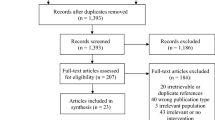Abstract
This article reports on a qualitative process evaluation aimed at elucidating and understanding the internal dynamics of program operation—the incorporation of a developmental, sensory-motor, trauma affect regulation curriculum into a children and adolescent partial hospitalization program. Through focus groups and individual interviews, data was collected from those who support the young people at home and within the program. The perceptions of these adults indicated that the intervention had produced positive outcomes in the children and adolescents. We attended to children and adolescents with trauma-related issues to ensure that their support systems at home and in the program were appropriately informed so as to provide optimal support and treatment.
Similar content being viewed by others
References
Arvidson, J., Kinniburgh, K., Howard, K., Spinazzola, J., Strothers, H., Evans, M., & Blaustein, M. E. (2011). Treatment of complex trauma in young children: Developmental and cultural considerations in application of the ARC intervention model. Journal of Child & Adolescent Trauma, 4, 34–51. doi:10.1080/19361521.2011.545046.
American Psychiatric Association. (2000). Diagnostic and statistical manual of mental disorders (4, text revisedth ed.). Washington, DC: Author.
Bloom, S. (1997). Creating sanctuary: Toward an evolution of sane societies. New York, NY: Routledge.
Cicchetti, D., & Rogosch, F. A. (1994). The toll of child maltreatment on the developing child. Child and Adolescent Psychiatric Clinics of North American, 3(4), 759–776.
Cicchetti, D., & Toth, S. L. (1995). A development psychopathology perspective on child abuse and neglect. Journal of the American Academy of Child and Adolescent Psychiatry, 34(5), 541–565.
Cohen, J. A., Berliner, L., & Mannarino, A. (2010). Practical strategies: Trauma focused CBT for children with co-occurring trauma and behavior problems. Child Abuse & Neglect, 34, 215–224. doi:10.1016/j.chiabu.2009.12.003.
Cook, A., Spinazzola, J., Ford, J., Lanktree, C., Blaustein, M., Cloitre, M., & van der Kolk, B. (2005). Complex trauma in children and adolescents. Psychiatric Annals, 35(5), 390–398.
Dennison, P. E., & Dennison, G. E. (1985). Personalized whole brain integration: The basic II manual on educational kinesiology. Ventura, CA: Edu-Kinesthetics.
Grizenko, N. (1997). Outcome of multimodal day treatment for children with severe behavior problems: A five-year follow-up [Electronic version]. Journal of the American Academy of Child and Adolescent Psychiatry, 36(7), 989–997.
Hannaford, C. (1995). Smart moves: Why learning is not all in your head. Arlington, VA: Great Ocean Publishers.
Herman, J. (1997). Trauma and recovery: The aftermath of violence—from domestic abuse to political terror. New York, NY: Basic Books.
James, B. (1994). Handbook for treatment of attachment-trauma problems in children. New York, NY: The Free Press.
Jankoski, J. A. (2011). Is vicarious trauma the culprit? A study of child welfare professionals. Child Welfare Journal, 89(6), 105–120.
Kerig, P. K., Fedorowicz, A. E., Brown, C. A., & Warren, M. (2000). Assessment and intervention for PTSD in children exposed to violence. Journal of Aggression, Maltreatment and Trauma, 3(1), 161–184.
Kreuger, R. A., & Casey, M. A. (2000). Focus groups: A practical guide for applied research (3rd ed.). Thousand Oaks, CA: Sage Publications.
Lewis, M., & Ippen, C. (2004). Rainbows of tears, souls full of hope: Cultural issues related to young children and trauma. In J. Osofsky (Ed.), Young children and trauma: Intervention and treatment (pp. 11–43). New York: NY: Guilford.
Martin, C. G., Cromer, L. D., & Freyd, J. J. (2010). Teachers’ beliefs about maltreatment effects on student learning and classroom behavior. Journal child and Adolescents Trauma, 3, 245–254.
Maughn, A., & Cicchetti, D. (2002). Impact of child maltreatment and interadult violence on children’s emotion regulation abilities and socioemotional adjustment. Child Development, 73(5), 1525–2542.
McDonald, R., Jouriles, E. N., Ramisetty-Mikler, S., Caetano, R., & Green, C. E. (2006). Estimating the number of American children living in partner-violent families. Journal of Family Psychology, 20(1), 137–142. doi:10.1037/0893-3200.20.1.137.
Merriam, S. B. (1998). Qualitative research and case study applications in education. San Francisco, CA: Jossey-Bass.
National Center for Children Exposed to Violence. (2006). Children & violence. Retrieved from http://www.nccev.org/violence/index.html
National Child Traumatic Stress Network. (NCTSN, 2003). Complex trauma in children and adolescents. Retrieved from http://www.NCTSNet.org
Ogden, P., Minton, K., & Pain, C. (2006). Trauma and the body: A sensorimotor approach to psychotherapy. New York, NY: W. W. Norton.
Patton, M. Q. (2002). Qualitative research & evaluation methods (3rd ed.). Oaks, CA: Sage Publications.
Perry, B. D. (1994). Neurobiological sequelae of childhood trauma: Post traumatic stress disorders in children: Emerging concepts (pp. 253–276). Washington, DC: American Psychiatric Press.
Perry, B. D. (1997). Incubated in terror: Neurodevelopmental factors in the ‘cycle of violence’ [Electronic version]. In J. Osofsky (Ed.), Children, youth and violence: The search for solutions (pp. 124–148). New York, NY: Guilford Press.
Perry, B. D. (2000). The vortex of violence: How children adapt and survive in a violent world [booklet] Houston. TX: The Child Trauma Academy.
Putnam, F. W. (1997). Dissociation in children and adolescents: A developmental perspective. New York, NY: The Guilford Press.
Rossman, B. B. R., & Ho, J. (2000). Posttraumatic response and children exposed to parental violence. Journal of Aggression, Maltreatment & Trauma, 3(1), 85–106.
Schein, E. H. (1990). Organizational culture. American Psychologist, 45(2), 109–119.
Schore, A. N. (2002). Dysregulation of the right brain: A fundamental mechanism of traumatic attachment and the psychpathogenesis of posttraumatic stress disorder [Electronic version]. Australian and New Zealand Journal of Psychiatry, 36, 9–30.
Siegel, D. (1999). The developing mind: Toward a neurobiology of interpersonal experience. New York, NY: The Guilford Press.
Sroufe, L. A., & Rutter, M. (1984). The domain of developmental psychopathology. Child Development, 55, 17–29.
Sue, D. W., Carter, R. T., Casas, J. M., Fouad, N. A., Ivey, A. E., Jensen, M., & Vazquez-Nutall, E. (1998). Multicultural counseling competencies: Individual and organizational development. Oaks, CA: Sage Publications.
Author information
Authors and Affiliations
Corresponding author
Rights and permissions
About this article
Cite this article
Malone, B.P., Jankoski, J.A. Perceptions of Vested Adults on the Effects of a Trauma Affect Regulation Curriculum at a Children’s Partial Hospitalization Program. Journ Child Adol Trauma 7, 97–106 (2014). https://doi.org/10.1007/s40653-014-0013-0
Published:
Issue Date:
DOI: https://doi.org/10.1007/s40653-014-0013-0




